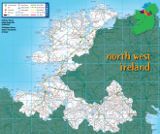North West Ireland Tourism
Visitor Guide to Mayo, Sligo, Donegal, Roscommon, Leitrim, Cavan & Monaghan
Visitor Guide to Mayo, Sligo, Donegal, Roscommon, Leitrim, Cavan & Monaghan
| 0-9 A B C D E F G H I J K L M N O P Q R S T U V W X Y Z |
Fahan
A unique feature of Fahan is a finely carved cross-slab to the east of the modern church which dates from the 7th-9th century. The only Greek inscription known from early Christian Ireland is on one face and reads "Glory and honour to the Father Son and Holy Spirit". Another cross-slab is set into the wall outside the cemetery. The crozier of St. Mura, the first abbot of the original 7th century monastery, and the shrine of St. Mura's Bell, are in the National Museum in Dublin.
Fahan is located on Lough Swilly, just 8 miles from the historic city of Derry. Nestled at the base of the Inishowen Hills, and overlooking the broad expanse of the Lough, the village makes an ideal base for a touring holiday of Donegal. Buncrana, just 6km to the north along the coast, is the regional capital of the Inishowen Peninsula, and has many fine pubs and restaurants for you to savour. It also has a public swimming pool, and a nine hole golf course. For the more adventurous golfer, the 18-hole course at Northwest Golf Club is just 5 minutes’ drive away. And Fahan is home, too, to one of the largest and best equipped marinas on the North Coast, making this an ideal destination for sailing and boating enthusiasts. And, of course, Fahan is amply provided with safe sandy bathing beaches on the northern end of the village, and on Inch Island.
But Fahan is steeped in a rich history too. A unique feature of the monastic site at Fahan is a finely carved cross-slab to the east of the modern church which dates from the 7th to 9th century. The only Greek inscription known from early Christian Ireland is on one face and reads "Glory and honour to the Father Son and Holy Spirit". Another cross-slab is set into the wall outside the cemetery. The crozier of St. Mura, the first abbot of the original 7th century monastery, and the shrine of St. Mura's Bell, are in the National Museum in Dublin.
The monastic site at Fahan was founded by St Mura in the 6th century. Originally the monastery was known as “Othan Mor”, but after St Mura’s death became known as “Fahan Mura”. The greatest point of interest at this site today is the beautifully decorated 7th century cross slab located in the graveyard. It was generally believed that this cross slab at Fahan Mura was a precursor to the Irish High Crosses, although in recent studies it is suggested the slab may be of a later date.
The west face of the Fahan Mura slab is beautifully decorated. The tree of life is represented by intertwining bands of ribbon following around five sun motifs that represent fruit. The tree of life has its roots in the ground, and its branches high in the air, representing a connection between heaven and earth. It is a symbol of growth, death, and rebirth. Carved on either side of the trunk are two figures, possibly representing Áed Uaridnach (High King of Ireland) and Saint Mura, founders of the church at Fahan. But could they instead represent pilgrims? Was Fahan Mura, along with Carndonagh, also an early pilgrimage site. You can explore this wonderful site yourself and come to your own conclusions, but either way, it is quite extraordinary to think that these artefacts have survived here for more than 1300 years.
Book Fahan Accommodation
Fahan is located on Lough Swilly, just 8 miles from the historic city of Derry. Nestled at the base of the Inishowen Hills, and overlooking the broad expanse of the Lough, the village makes an ideal base for a touring holiday of Donegal. Buncrana, just 6km to the north along the coast, is the regional capital of the Inishowen Peninsula, and has many fine pubs and restaurants for you to savour. It also has a public swimming pool, and a nine hole golf course. For the more adventurous golfer, the 18-hole course at Northwest Golf Club is just 5 minutes’ drive away. And Fahan is home, too, to one of the largest and best equipped marinas on the North Coast, making this an ideal destination for sailing and boating enthusiasts. And, of course, Fahan is amply provided with safe sandy bathing beaches on the northern end of the village, and on Inch Island.
But Fahan is steeped in a rich history too. A unique feature of the monastic site at Fahan is a finely carved cross-slab to the east of the modern church which dates from the 7th to 9th century. The only Greek inscription known from early Christian Ireland is on one face and reads "Glory and honour to the Father Son and Holy Spirit". Another cross-slab is set into the wall outside the cemetery. The crozier of St. Mura, the first abbot of the original 7th century monastery, and the shrine of St. Mura's Bell, are in the National Museum in Dublin.
The monastic site at Fahan was founded by St Mura in the 6th century. Originally the monastery was known as “Othan Mor”, but after St Mura’s death became known as “Fahan Mura”. The greatest point of interest at this site today is the beautifully decorated 7th century cross slab located in the graveyard. It was generally believed that this cross slab at Fahan Mura was a precursor to the Irish High Crosses, although in recent studies it is suggested the slab may be of a later date.
The west face of the Fahan Mura slab is beautifully decorated. The tree of life is represented by intertwining bands of ribbon following around five sun motifs that represent fruit. The tree of life has its roots in the ground, and its branches high in the air, representing a connection between heaven and earth. It is a symbol of growth, death, and rebirth. Carved on either side of the trunk are two figures, possibly representing Áed Uaridnach (High King of Ireland) and Saint Mura, founders of the church at Fahan. But could they instead represent pilgrims? Was Fahan Mura, along with Carndonagh, also an early pilgrimage site. You can explore this wonderful site yourself and come to your own conclusions, but either way, it is quite extraordinary to think that these artefacts have survived here for more than 1300 years.
How to get to Fahan
By bus or car. Foyle Coaches provide a daily service from Letterkenny to Fahan. Alternatively follow the N13 and the R238 from Letterkenny to Fahan.Where to stay in Fahan
Fahan has plenty of good accommodation options including small hotels, hostels, self-catering holiday homes, guesthouses and B&B's.Book Fahan Accommodation
Explore more
Fahan is surrounded by beautiful coastal towns. Don't miss Buncrana and Dunaff if you are travelling east, and Letterkenny and Ramelton if you are travelling west.Things to do in Fahan & Inch
- Explore the ecclesiastical ruins of Fahan Mura, and particularly the inscriptions in its historic graveyard. Find the Fahan Mura Slab and marvel at the abilities of its sculptors all those years ago.
- Enjoy an evening time swim on the tiny beach at the north end of Inch Island. A gentle spot, and a lovely way to while away an evening.
- Follow the shorelines of Inch Island, alternating between the foreshore and the roadways as required. Catch lovely views of Lough Swilly and happen across some very fine old buildings.
- For sailing enthusiasts, Lough Swilly Yacht Club is situated here and a 350-berth marina has been developed.






